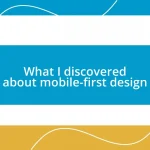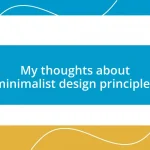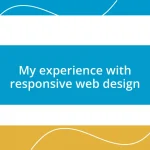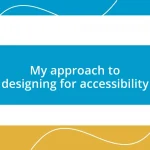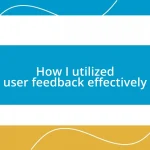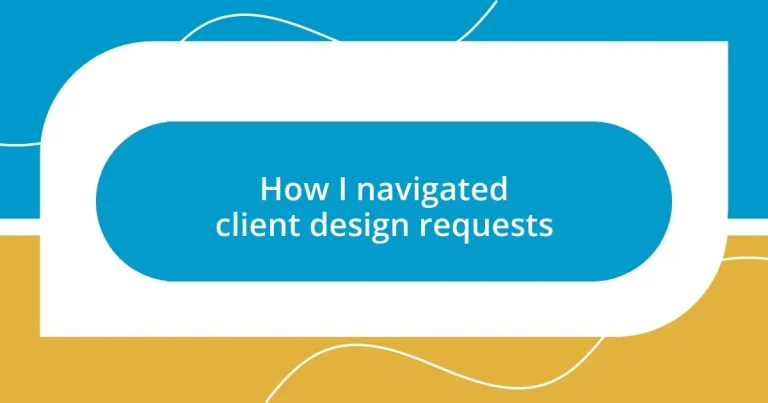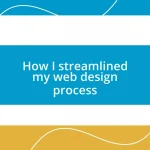Key takeaways:
- Understanding client design needs requires active listening and effective questioning to clarify vague terms and uncover deeper preferences.
- Using visuals and simplifying terminology during presentations helps clients engage and understand design concepts more clearly.
- Feedback should be viewed as a growth opportunity, with a focus on collaborative revisions and transparent documentation of design decisions.
- Storytelling during the design presentation fosters connection and excitement, setting a positive tone for the next steps in the project.
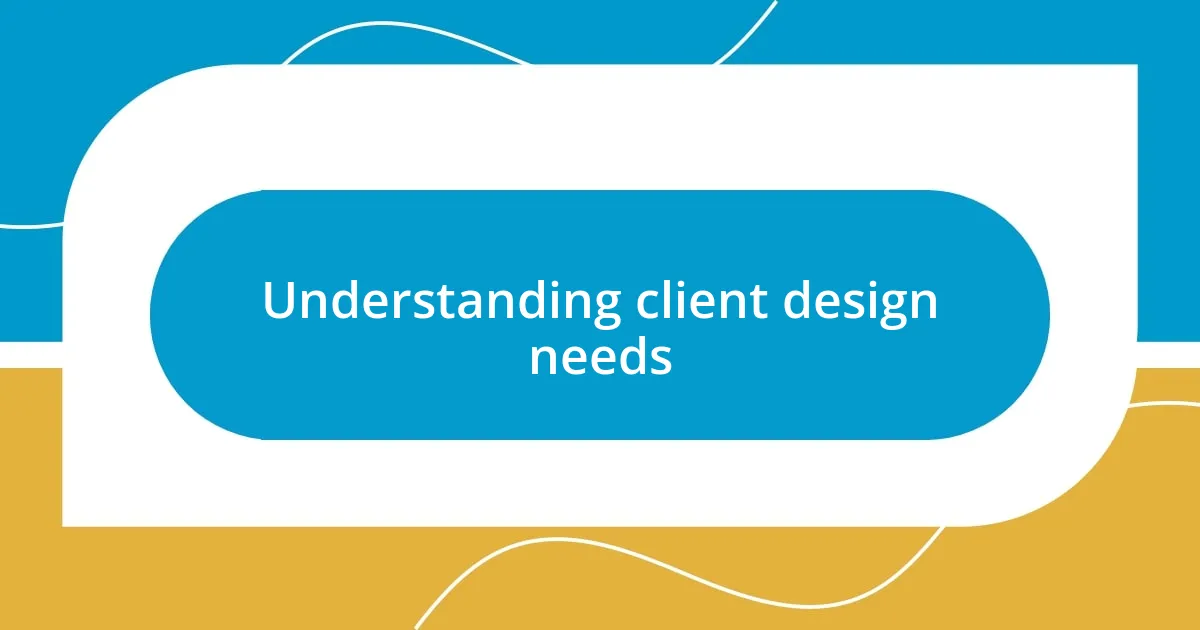
Understanding client design needs
Understanding client design needs involves a delicate balance between listening and interpreting. I remember one project where a client used vague terms like “modern” and “fresh.” This left me wondering—what did they truly envision? I quickly learned that asking specific questions not only clarified their desires but also empowered them to articulate their vision more vividly.
One time, a client came in with a Pinterest board filled with beautifully curated images. While I was excited by their enthusiasm, I felt a knot in my stomach; how would I translate that array of styles into a cohesive design? I gently guided them through their selections, encouraging them to express what drew them to each image. This conversation unveiled deeper preferences that had been obscured by their initial inspiration.
Being attentive to a client’s emotions can make or break a project. I recall a situation where my careful probing revealed a client’s hesitance to stray from traditional aesthetics due to fear of disapproval from family. By creating a safe space for them to express these feelings, we collaboratively navigated their design needs, culminating in a solution that honored their style while embracing a touch of innovation. Isn’t it fascinating how emotions play a pivotal role in shaping design preferences?
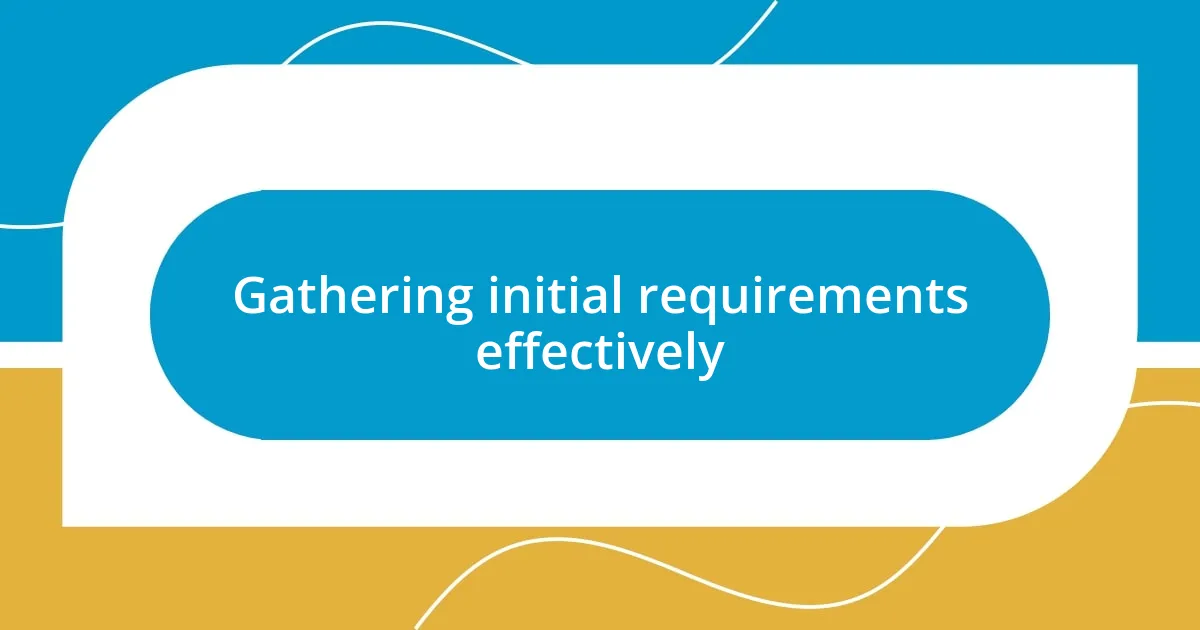
Gathering initial requirements effectively
When gathering initial requirements, I’ve found it’s crucial to set the stage for open dialogue. In one project, I scheduled a casual coffee meeting with my client instead of a formal interview. We talked about their lives, which led to a revelation about their love for nature-inspired designs. By creating a relaxed atmosphere, I encouraged them to share ideas and feelings organically.
To guide this process effectively, I now rely on specific strategies:
– Use open-ended questions: Asking questions that require more than a yes or no response invites deeper conversation.
– Visual aids: Incorporating mood boards or sketches can help clarify initial ideas, sparking insightful discussions.
– Listen actively: I’ve learned that reflecting back what I hear ensures clients feel understood, paving the way for trust.
– Clarify terms: If a client uses terms like “chic” or “classic,” I dive deeper to get specific examples of what they envision.
These simple strategies transform the initial requirement-gathering process into a collaborative experience, ultimately shaping a design that truly resonates with the client’s vision.
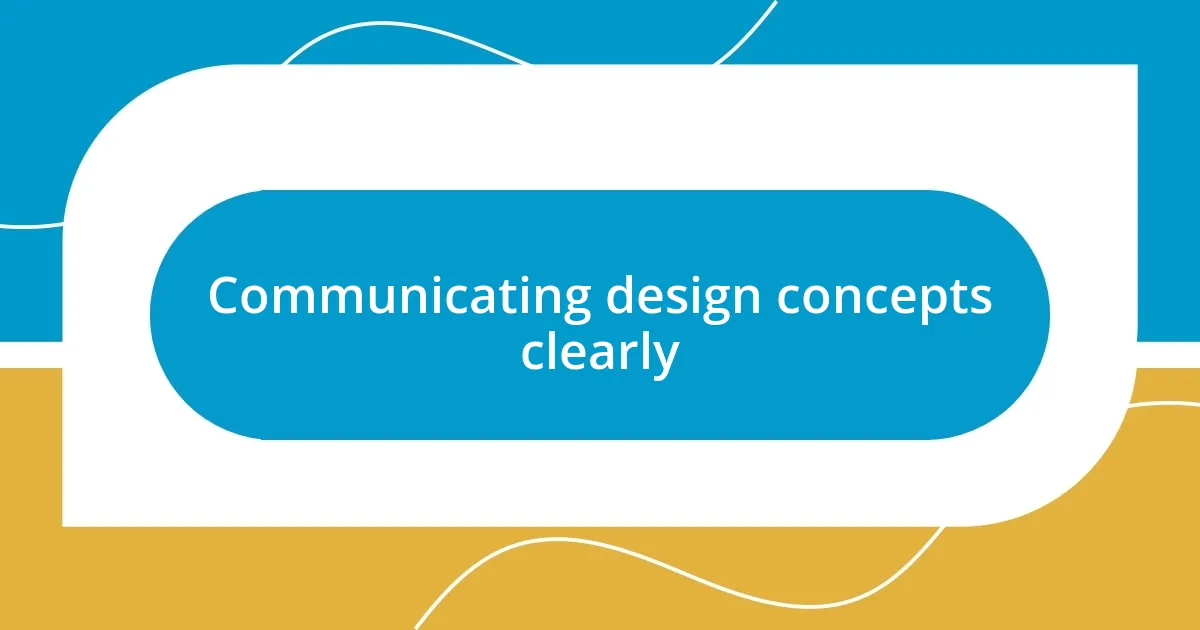
Communicating design concepts clearly
When it comes to communicating design concepts clearly, I’ve learned that visuals are essential. I remember one memorable meeting where I presented a design mock-up that initially felt like a leap of faith. The client’s eyes lit up when they saw the transformative power of colors and layouts brought to life in front of them. This experience reinforced my belief that visual representations can bridge the gap between abstract ideas and concrete understanding.
It’s also about simplifying the terminology. One time, I used design jargon to explain a concept, and I could see the confusion on my client’s face. So, I quickly shifted gears, breaking down the terms into relatable language. This moment taught me that keeping things straightforward not only helps clients feel more comfortable but also empowers them to engage in the design conversation. When they can understand the language of design, they’re more likely to contribute meaningfully.
Lastly, regular check-ins throughout the design process can’t be overstated. I had a project where, after the first draft was presented, the feedback session turned into a brainstorming session. The client shared ideas that ultimately refined the direction of the project. This back-and-forth exchange helped both of us align on the vision. I realized then how crucial it is not to wait until the end of the process to share concepts. Communication is a continuous thread that can enhance trust and creativity.
| Strategy | Description |
|---|---|
| Use visuals | Present design mock-ups or mood boards to illustrate concepts clearly. |
| Simplify language | Avoid jargon; use relatable terms to foster understanding. |
| Regular check-ins | Schedule frequent discussions to gauge understanding and gather real-time feedback. |
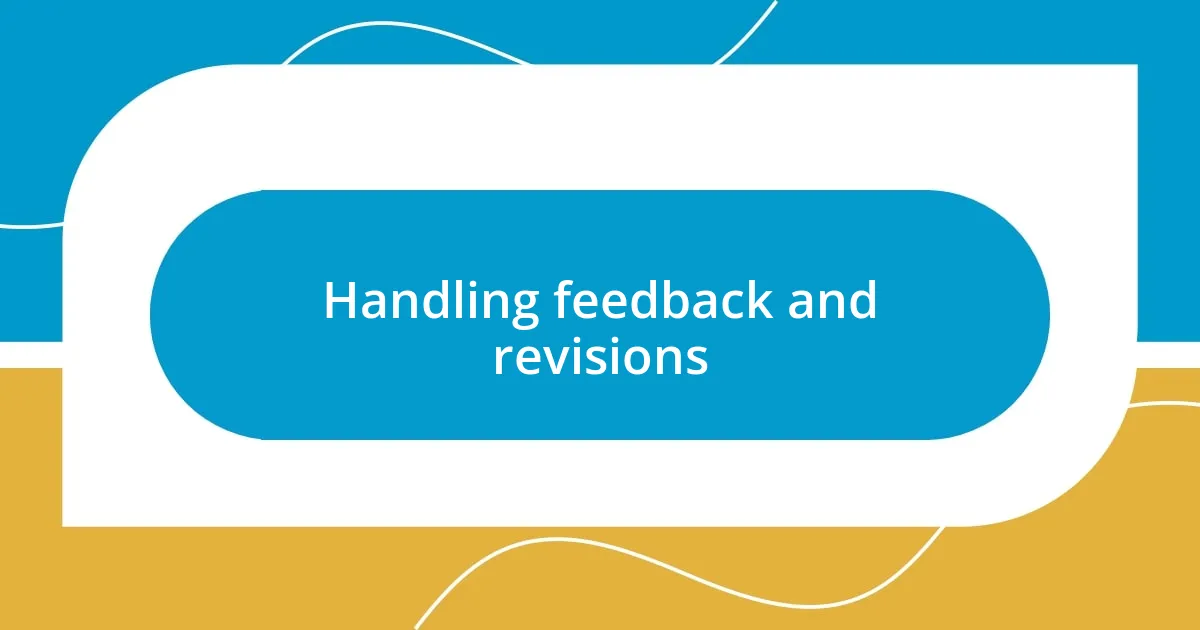
Handling feedback and revisions
When feedback rolls in, I see it as a crucial opportunity for growth, not just for the design but for the relationship with the client. I vividly recall a tense moment when a client expressed dissatisfaction with a logo design I was excited about. Instead of retreating, I invited them to elaborate on their feelings. This honesty led to an inspiring discussion that reshaped my understanding of their vision and ultimately resulted in a design that resonated with them so much more deeply. Isn’t it fascinating how discomfort can usher in clarity?
Revisions can be draining if not approached thoughtfully. I once embarked on a project that required multiple back-and-forth revisions—each one a chance to refine and elevate the idea. I made it a point to create a revision tracker, which not only organized feedback but also allowed the client to see progress. This tool eased their anxiety and turned the revisions into a collaborative journey rather than a daunting task. By sharing this proactive approach, I found that clients were more willing to express their thoughts and felt more involved in the creative process.
After all, isn’t it the dialogue that enriches the design? When a client highlights specific aspects they love or wish to change, I prioritize those insights. I remember one client was unsure about the color palette; they thought it was too bold. By encouraging them to share their personal preferences, I was able to suggest a vibrant yet harmonious color scheme that connected to their brand’s story. I realized that feedback isn’t just a critique; it’s a treasure trove of ideas waiting to be uncovered, and it’s my job to guide that exploration.
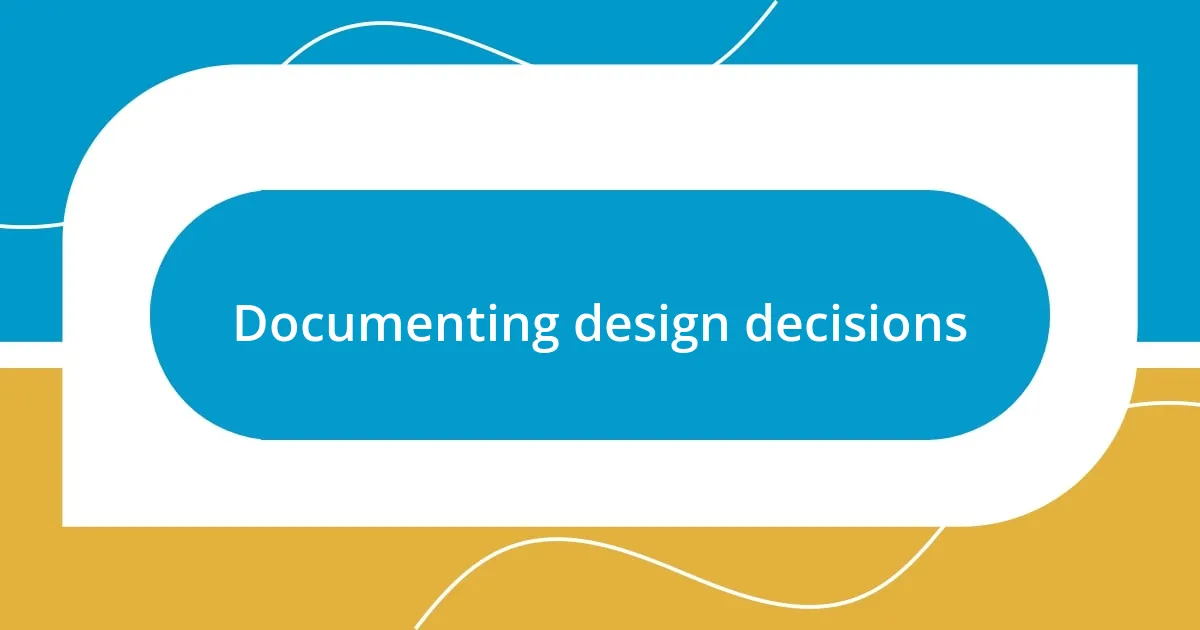
Documenting design decisions
Documenting design decisions is an essential part of the creative process, one that I’ve found fosters transparency and understanding. In my experience, I often create a design rationale document for each project, outlining the thought process behind significant choices. This practice not only provides the client with a clear reference point but also helps me articulate my design philosophy, ensuring that every decision aligns with their vision.
There was a project where I faced numerous design pivots based on client feedback. I started jotting down each decision I made and the reasoning behind it in a shared document. This transparency resulted in a delightful surprise: my client felt more involved in the process because they could see how their feedback genuinely influenced the design. It became a collaborative map of our journey, and it made me realize how vital it is to keep that dialogue open.
Have you ever considered how insightful it can be to revisit past design decisions? I remember reflecting on a project long after it was completed, seeing the evolution of the design through the decisions we documented. That exercise not only improved my future design processes but also deepened my understanding of the client’s brand identity. By capturing every insight, preference, and change, I could create a richer design narrative that resonated with both my and the client’s intent.
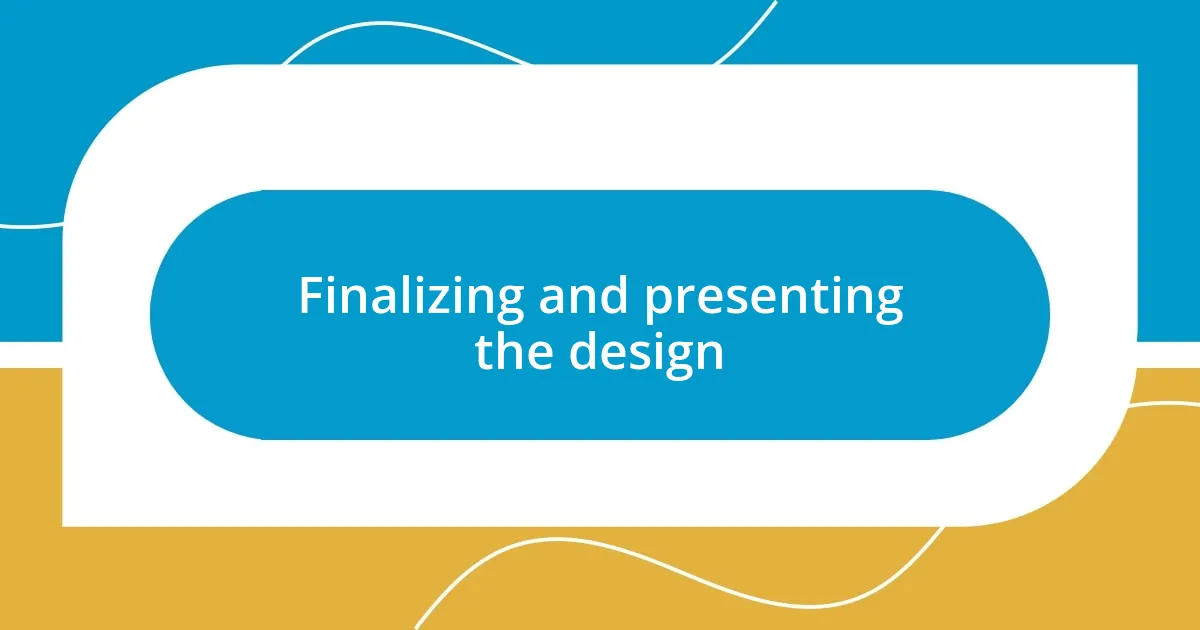
Finalizing and presenting the design
Finalizing a design is often the moment where anticipation and anxiety collide. I vividly remember presenting a website design to a client, feeling a mix of excitement and nervousness. As I walked them through each element, their initial silence felt palpable, but then, a smile broke across their face. That moment reassured me that I was hitting the mark. Isn’t it remarkable how a single reaction can transform your entire perspective on the work?
When it comes to presenting a design, I’ve found that storytelling can be incredibly powerful. During one project, instead of simply displaying the visuals, I wove a narrative around the design journey—sharing insights about inspiration, process, and the evolution of ideas. This approach not only sparked interest but also created a connection, making the design feel more like a shared experience than just another deliverable. Have you ever noticed how people resonate more with a story than with just pixels on a screen?
Finally, discussing next steps is crucial to anchoring the presentation positively. After showcasing the final design, I always make it a point to map out a timeline for implementation and feedback. In one instance, this inclusion led to a follow-up meeting that I hadn’t anticipated. The client was so enthused about the design that they wanted to dive immediately into the next phase! It’s moments like these that remind me: finalizing a design isn’t merely about completion; it’s about igniting excitement for what’s next. How do you keep that momentum going in your projects?


